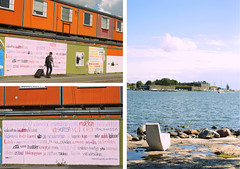| Multiple racks of servers (Photo credit: Wikipedia) |
If you are still looking to rent hosting resources rather than invest in your own in-house IT to get your website up and running there are further channels which can provide alternatives to buying physical service space directly from a hosting provider and which have particular appeal to smaller scale clients.
Resellers
For those still looking to rent server space there is the additional option of using a hosting reseller rather than buying directly from the hosting provider. A reseller will buy up hosting resource, disk space and bandwidth wholesale and then sell on hosting packages to individual clients by dividing up these resources. They can add a layer of support to their offering if they are specialist resellers and some will include their own branded control panels to allow clients to configure their hosting platforms.
There are specialist reseller companies in the market, but there are also many organisations that either sell hosting as an add-on to another service, such as digital media companies who build or maintain web sites, or that need to buy their own hosting resource and find it economical to buy wholesale and then resell the excess that they don’t use to counterbalance their own costs.
The hosting packages on offer from resellers can incorporate both shared or dedicated hosting platforms as resellers can either sell on a certain amount of shared disk space or complete individual servers. The most common reseller packages, however, involve shared hosting and in particular Virtual Private Servers (VPS) where the shared servers use virtual partitions to create distinct operating environments.
Reseller packages can be particularly beneficial for clients that do not have the expertise or resource to work with their underlying service provider in maintaining their platform. They can, depending on the package, have no need to be involved, direct or indirectly, in maintaining any of the hardware and infrastructure themselves. The reseller can effectively act as a conduit between the client and the service provider, either working alongside them to resolve any issues that crop up on behalf of the client, or acting as a middle man with whom the client may find easier to deal than the underlying service provider, especially if the client isn’t overly confident with their own technical awareness. For those who do get more involved, the packaging of reseller hosting can be less esoteric and easier for private and small business users to understand making use, for example, of simple control panel interfaces for configuration changes.
In addition, the reseller-support dynamic works well where the reseller is involved in other elements of a client’s digital package, such as the aforementioned digital agency who would build and maintain a site and then liaise with the hosting provider to manage the hosting of the site as part of a more holistic and joined up approach.
The twin drawbacks of reseller hosting, however, are that it can introduce an added layer of cost and, for those who do have the technical awareness, the middle man is simply another level of communication when support is required. Instead, tech savvy clients in particular, may prefer to deal directly with service provider to resolve issues more expeditiously.
Cloud Hosting
A newer alternative to the more traditional idea of renting a portion of a server is the idea of renting space within a cloud of hosting resource. This service relies on the hosting provider pooling the physical resources they have - disk space, bandwidth etc - and offering consumers a virtualized platform within this virtualized pool of computing resource on which to host their site. The consumer does not rent space on, or the entirety of, a single physical server therefore, and instead their site will in reality be drawing resource from a network of multiple physical servers. The environments in which their hosting platforms exist will be distinct in a virtual sense rather than a physical one, by employing virtual partitions (similar to VPS). Consumers can even go one step further and rent an entire network of virtual servers to form a Virtual Data Center (VDC) to satisfy any of their web hosting or broader business hosting needs.
Hosting in the cloud sits within the Infrastructure as a Service (IaaS) band of cloud services and its dynamics mean that hosting resource is sold more like a utility which can be tapped into as and when it is needed. The virtualized hosting platforms can be scaled to suit the demand for resources because they are freed of physical constraints and the consumer need only pay for the resource that they need as and when they use it; negating the wasted capacity that could otherwise result from either in-house hosting or rented disk space (especially dedicated servers). What’s more, the economies of scale that the hosting provider generates by running large scale data center resources can be passed down to the consumer meaning that cloud hosting can also be a cost effective way for the consumer to access the particular levels of resource that they need.
Whatever your budget, the technical demands of your website, your expertise and your expectations there is likely to be a hosting option on the market that suits. Ultimately, hosting packages will vary from one provider to the next but it is still important to be aware of the different routes that you can go down and the options you’ll find when you get there.
© Stuart Mitchell 2012






